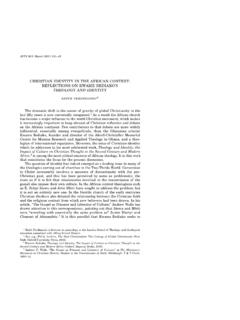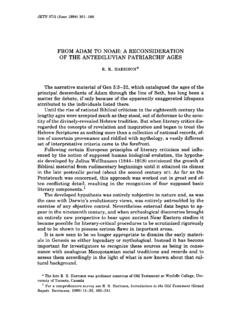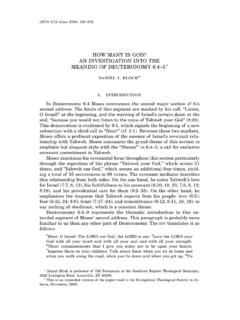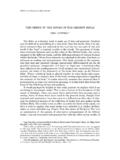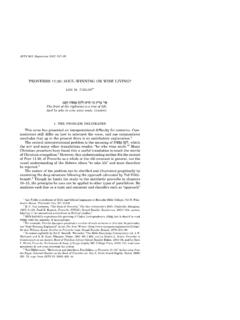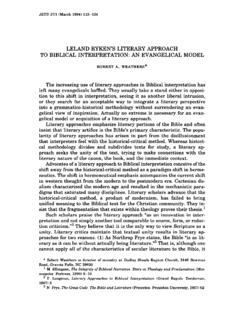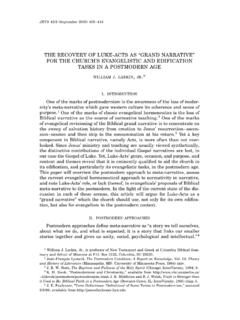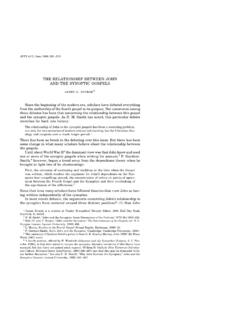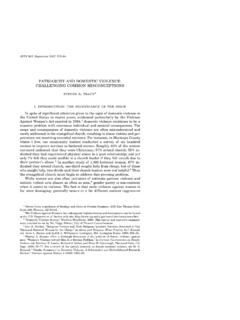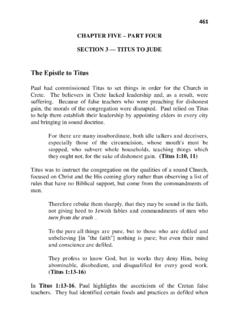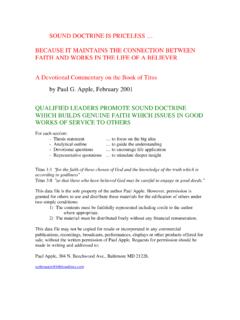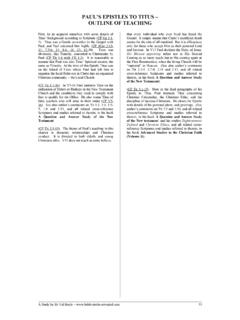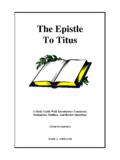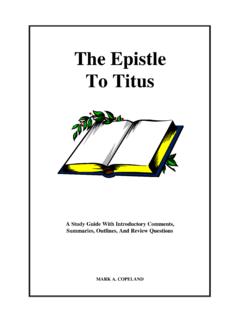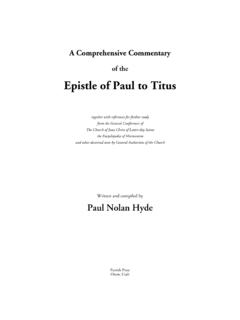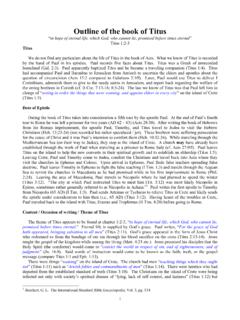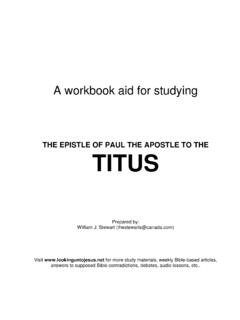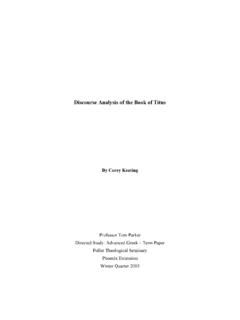Transcription of THE EARLIEST COLLECTION OF PAUL'S EPISTLES
1 THE EARLIEST COLLECTION OF PAUL'S EPISTLES LEWIS FOSTER, A study of the making of the New Testament indicates the presence of different stages through which the Scriptures passed before coming to their final form. First came the time of writing; but before all the writings were completed the period of COLLECTION had already begun; and finally the era of canonization provided the final form for the The purpose of this study is to essay the evidence for the EARLIEST COLLECTION of PAUL'S EPISTLES and, coming to a realization of the paucity of notices concerning the first COLLECTION , to offer suggestion by analogy and in-ference that would seem both probable and assist in treating other prob-lems associated with the writings of Paul. Failure to differentiate between the two periods of collecting and canonizing has led to frequent misinterpretation of detail.
2 Although the concept of the canon antedated the actual use of the term, it was not until the time of Athanasius (296-373) that the phrase "canon of Scripture" was employed to mean the list of books reckoned as Holy As far as our records go, it is not until the decade 170-180 that the church undertook seriously the task of drawing up such lists, the Muratorian Discussion concerning these lists continues to the time of the Synods at Carthage in 397 and Harnack describes the activity of the church in this period as that of "selection."5 In these years, he main-tained, the church was selecting which books belonged to the Bible and which did not. Zahn, however, was opposed to this concept of selection in the sense that the church was granting authority to the books by the decisions of the councils; but Zahn emphasized the idea of "growth.
3 "6 As each book of Scripture was written it was immediately received as divine-ly authoritative by those to whom it was directed and remained authori-tative as the writing began to circulate and was incorporated into collec-tions. Whereas Harnack's concept of "selection" is misleading in describ-ing the work done in the period of the canon, it can also be pointed out that Zahn's emphasis upon "growth" is more appropriate for the periods of writing and collecting rather than the technical period of canonizing 1. The major problem of the New Testament Canon is ascertaining the stages of development, interpreting these stages, determining the authority of these writ-ings at each stage and establishing the source of authority. Kurt Aland, The Prob-lem of the New Testament Canon (1962), esp. pp. 8-13, represents the Liberal approach seated in human authority and maintaining a right to select a new canon within a canon for today.
4 Herman Ridderbos, The Authority of the New Testament Scriptures (1963), no less aware of stages of development, repre-sents acceptance of the New Testament Canon upon divine authority and closed. 2. See F. F. Bruce, The Books and the Parchments (1950), p. 94. Also Journal of Theological Studies, 49 (1948), 17-27. 3. B. F. Westcott, The Canon of the New Testament ( 1 8 8 15 ), pp. 21 Iff. 4. K. Aland, op. cit. p. 11. 5. A. Harnack, The Origin of the New Testament (1925). See also E. C. Blackman, Marcion and His Influence ( 1 9 4 8 ), p. 35. 6. Th. Zahn, Geschichte des Neutestamentlichen Kanons I ( 1888-89). 44 FOSTER: THE CANON OF THE BIBLE 45 in the years 180-397 when this growth would have already been com-plete. A better word to characterize the period of the canon is "protection.
5 " This is the period when a wall was built around the village that had already been there for years; but now, both to protect the original, in-spired inhabitants and to keep out uninspired newcomers, the protection of the canonical wall is erected to assure safety and preservation. Author-ity was not gained by including a book in the sacred list but it appeared in the list of Scripture because its authority had already been acknowl-edged throughout the earlier periods of writing and The period of COLLECTION is not so clearly marked off as that of the canon. Different parts of the New Testament belonged to different collections, some made earlier than others. The Diatessaron is one ex-ample of the Gospel COLLECTION that must have been brought together years earlier than the Diatessaron's publication c. 150; for Tatian used for his consecutive narrative these four canonical Gospels, no more and no less.
6 Also the EPISTLES of Paul must have been collected as soon or sooner than the Gospels as witnessed by early references and usage. Earlier than the work of Tatian is the COLLECTION of books used as Scrip-ture by This included Luke and ten EPISTLES of Paul, known as the Gospel and Apostle. Similar designation had already been used by Another striking reference comes from the conglomerate Jewish-Christian writing, The Testaments of the XII Patriarchs (Benj. II)10 where it is told under cover of an ex post facto prophecy that the "work and word" of Paul ( W a r f i e ld notes this is confessedly the book of Acts and PAUL'S EPISTLES ),11 "shall be written in the Holy Books" , as is generally accepted, made a part of the existent Another in-teresting reference is found in the Acts of the Scillitan Martyrs (c. 180) where the contents of the satchel of the martyr Speratus are described as "books and EPISTLES of Paul a just man.
7 "13 The "books" may or may not refer to the Gospels and Acts but the second designation is explicitly the EPISTLES of Paul. Just as the old Scriptures were the 'law and the prophets" 7. See F. F. Bruce, op. cit., pp. 94, 95. See also B. B. Warfield, The Inspiration and Authority of the Bible (reprint 1948), pp. 411-16. Warfield's emphasis in his study of the canon could be characterized by the word, "extension," for he focuses on the new Scripture as a continuance or extension of the old. 8. G. Bardy, "Marcion," Dictionnaire de L Bible, Supplement, 5, fase. 27 (1954) 862-77; A. Harnack, Marcion ( 1921 ) ; J. Knox, Marcion and the New Testament (1942). Contemporary also to Marcion's time is the Gnostic Gospel of Truth which van Unnik maintains gives evidence of a New Testament canon similar to our own already in existence.
8 See The Jung Codex, F. L. Cross, ed. (1955), pp. 81-129. 9. Ad Phihd. 5. See B. B. Warfield, op. cit., pp. 413, 414. 10. "Until the consummation of the age shall he be in the synagogues of the Gentiles, and among their rulers, as a strain of music in the mouth of all. And he shall be inscribed in the holy books, both his work and his word, and he shall be a chosen one of God for ever." 11. Warfield, loc. cit. 12. See also II Clement 14 ( " t he books and the Apostles" ). 13. See Blackman, op. cit., p. 30. 46 BULLETIN OF THE EVANGELICAL THEOLOGICAL SOCIETY so the new were the Gospel and the apostles,14 but it is impossible to say how early these collections were As far back as our extracanonical, datable Christian literature goes, Christians were using the EPISTLES of Paul. It is noteworthy that when Clement of Rome wrote to the Corinthians, he did not neglect to mention PAUL'S epistle to them (I Clement ), when Ignatius wrote to the Ephesians, he referred to the EPISTLES of Paul (Ephesians 12:2), and when Polycarp wrote to the Ph ippians he too draws attention to the EPISTLES of Paul (Philip.)
9 In fact every time an Apostolic Father wrote to a place which had received an epistle of Paul, they made refer-ence to the apostle and his In the writings of Polycarp, one finds evidence of all of the EPISTLES of Paul except I Thessalonians, titus and The use of PAUL'S EPISTLES in the Apostolic Fathers leads one to a conviction that the COLLECTION of his EPISTLES must have been made prior to their But this brings one into the very period of the writing of the New Testament books for the collecting of PAUL'S EPISTLES . The question remains, how early in the first century was the COLLECTION made? In II Peter 3:15, 16 direct reference is made to "all of PAUL'S EPISTLES ." And account that the longsuffering of our Lord is salvation; even as our beloved brother Paul also according to the wisdom given unto him hath written unto you; as also in all his EPISTLES , speak-ing in them of these things; in which are some things hard to be understood, which they that are unlearned and unstable wrest, as they do also the other scriptures, unto their own destruction.
10 Since this passage not only indicates that PAUL'S EPISTLES have been col-lected but that they are also considered as Scripture, this notice is par-ticularly troublesome to those who would insist that these books must wait for the period of the canon for the church to select them. But in order to surmount this testimony the Liberal must deny the authorship of Peter to this second epistle and relegate it to the second century to fit 14. Clement of Alexandria, Strom. ; Tertullian, De Proes. Haer. 36. See . B. Warfield, op. cit., pp. 413, 14. 15. Streeter traces four stages of the Roman Corpus Paulinum beginning with I Clement, 96, The Four Gospels ( 1951 ), p. 526f. A gradual process over a period of years is advocated by Harrison, Polycarp's Two EPISTLES to the Philip-pians (1936), pp. 236ff. K.
